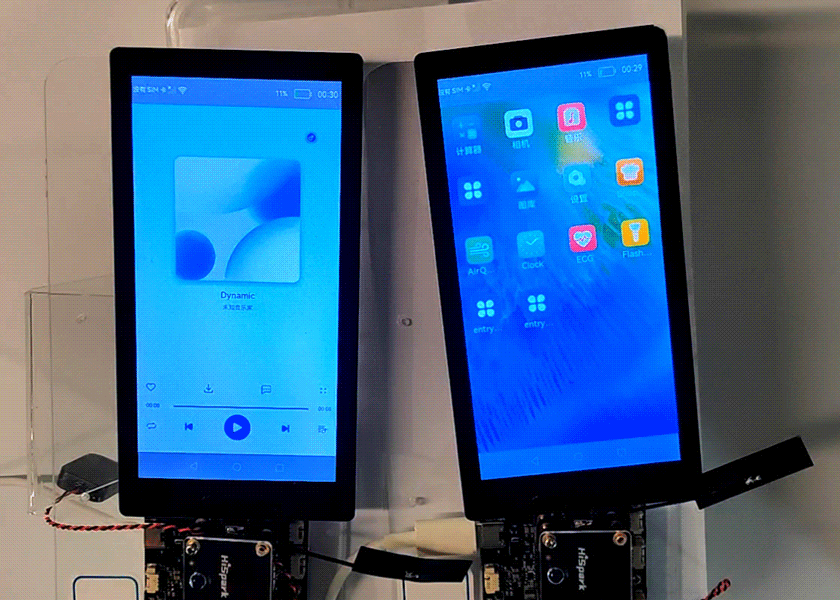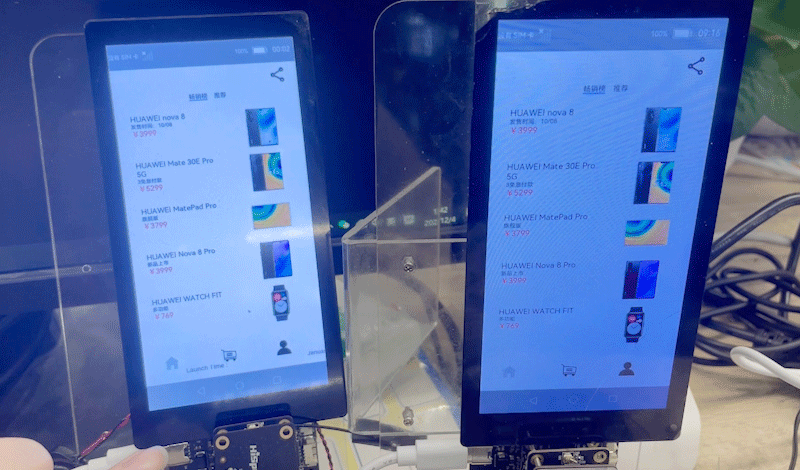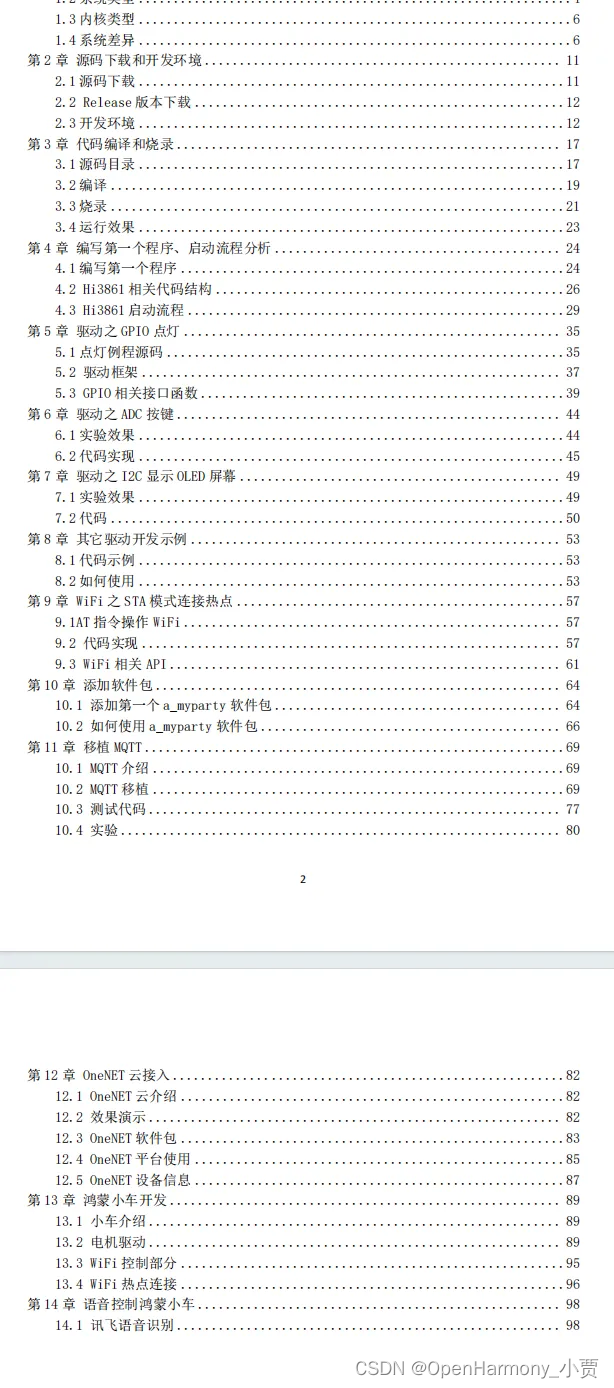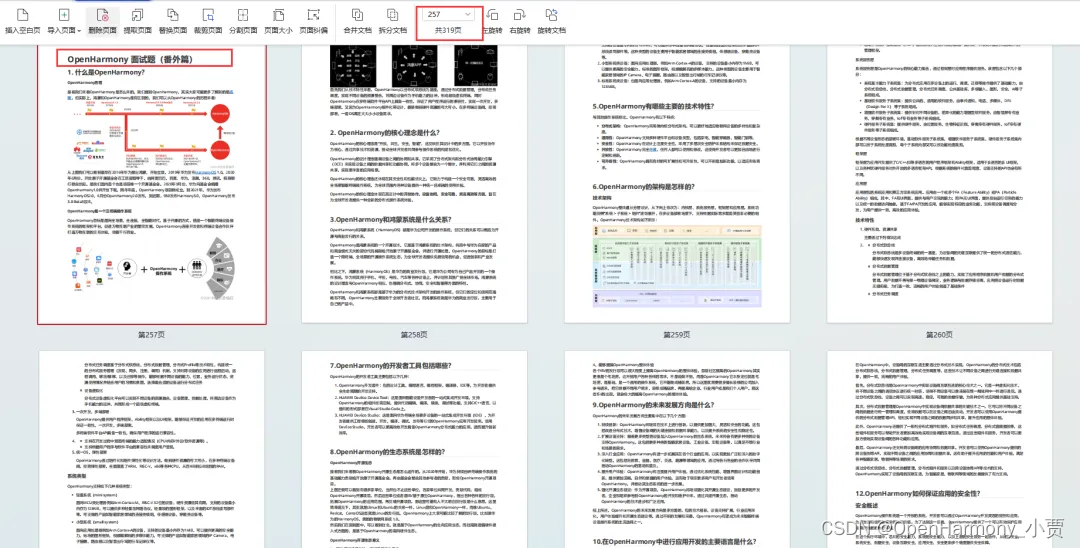- 1针对:copilot验证时,一直waiting的处理_copilot国内访问慢的问题
- 2从零开始,搭建springboot+Mybatis-plus+vue3+sqlServer系统_mybatisplus整合sqlserver
- 3cpu算力DMIPS说明
- 4《从零开始学python+自然语言处理100题》——给自己的记录_自然语言处理100练
- 5本地微服务springboot集成ftp服务器
- 6搜索语义模型的大规模量化实践
- 7平衡二叉搜索树及其java实现_平衡满二叉搜索树搜索java
- 8【学术技巧】让你的 GitHub 秒变高大上!
- 9输入序列太长 gan CGAN
- 10解决java.lang.IllegalArgumentException异常的正确解决方法_java.lang.illegalargumentexception: operation does
OpenHarmony标准设备应用开发(二)——布局、动画与音乐
赞
踩
本章是 OpenHarmony 标准设备应用开发的第二篇文章。我们通过知识体系新开发的几个基于 OpenHarmony3.1 Beta 标准系统的样例:分布式音乐播放、传炸弹、购物车等样例,分别介绍下音乐播放、显示动画、动画转场(页面间转场)三个进阶技能。首先我们来讲如何在 OpenHarmony 中实现音乐的播放。
一、分布式音乐播放
通过分布式音乐播放器,大家可以学到一些 ArkUI 组件和布局在 OpenHarmony 中是如何使用的,以及如何在自己的应用中实现音乐的播放,暂停等相关功能。应用效果如下图所示:

1.1 界面布局
整体布局效果如下图所示:

首先是页面整体布局,部分控件是以模块的方式放在整体布局中的,如 operationPannel()、sliderPannel()、playPannel() 模块。页面整体布是由 Flex 控件中,包含 Image、Text 以及刚才所说的三个模块所构成。
build() { Flex({ direction: FlexDirection.Column, alignItems: ItemAlign.Center, justifyContent: FlexAlign.SpaceBetween }) { Flex({ direction: FlexDirection.Column, alignItems: ItemAlign.Center }) { Flex({ direction: FlexDirection.Row, justifyContent: FlexAlign.End }) { Image($r("app.media.icon_liuzhuan")).width(32).height(32) }.padding({ right: 32 }).onClick(() => { this.onDistributeDevice() }) Flex({ direction: FlexDirection.Row, justifyContent: FlexAlign.Center }) { Image($r("app.media.Bg_classic")).width(312).height(312) }.margin({ top: 24 }) Text(this.currentMusic.name).fontSize(20).fontColor("#e6000000").margin({ top: 10 }) Text("未知音乐家").fontSize(14).fontColor("#99000000").margin({ top: 10 }) }.flexGrow(1) Flex({ direction: FlexDirection.Column, alignItems: ItemAlign.Center, justifyContent: FlexAlign.End }) { this.operationPannel() this.sliderPannel() this.playPannel() }.height(200) } .linearGradient({ angle: 0, direction: GradientDirection.Bottom, colors: this.currentMusic.backgourdColor }).padding({ top: 48, bottom: 24, left: 24, right: 24 }) .width('100%') .height('100%') }
- 1
- 2
- 3
- 4
- 5
- 6
- 7
- 8
- 9
- 10
- 11
- 12
- 13
- 14
- 15
- 16
- 17
- 18
- 19
- 20
- 21
- 22
- 23
- 24
- 25
- 26
- 27
- 28
- 29
- 30
- 31
- 32
operationPannel() 模块的布局,该部分代码对应图片中的心形图标,下载图标,评论图标更多图标这一部分布局。其主要是在 Flex 中包含 Image 所构成代码如下:
@Builder operationPannel() {
Flex({ direction: FlexDirection.Row, alignItems: ItemAlign.Center, justifyContent: FlexAlign.SpaceBetween }) {
Image($r("app.media.icon_music_like")).width(24).height(24)
Image($r("app.media.icon_music_download")).width(24).height(24)
Image($r("app.media.icon_music_comment")).width(24).height(24)
Image($r("app.media.icon_music_more")).width(24).height(24)
}.width('100%').height(49).padding({ bottom: 25 })
}
- 1
- 2
- 3
- 4
- 5
- 6
- 7
- 8
sliderPannel() 模块代码布局。该部分对应图片中的显示播放时间那一栏的控件。整体构成是在 Flex 中,包含 Text、Slider、Text 三个控件。具体代码如下:
@Builder sliderPannel() { Flex({ direction: FlexDirection.Row, alignItems: ItemAlign.Center, justifyContent: FlexAlign.Center }) { Text(this.currentTimeText).fontSize(12).fontColor("ff000000").width(40) Slider({ value: this.currentProgress, min: 0, max: 100, step: 1, style: SliderStyle.INSET }) .blockColor(Color.White) .trackColor(Color.Gray) .selectedColor(Color.Blue) .showSteps(true) .flexGrow(1) .margin({ left: 5, right: 5 }) .onChange((value: number, mode: SliderChangeMode) => { if (mode == 2) { CommonLog.info('aaaaaaaaaaaaaa1: ' + this.currentProgress) this.onChangeMusicProgress(value, mode) } }) Text(this.totalTimeText).fontSize(12).fontColor("ff000000").width(40) }.width('100%').height(18) }
- 1
- 2
- 3
- 4
- 5
- 6
- 7
- 8
- 9
- 10
- 11
- 12
- 13
- 14
- 15
- 16
- 17
- 18
- 19
- 20
- 21
- 22
- 23
- 24
- 25
- 26
- 27
playPannel() 模块代码对应图片中的最底部播放那一栏五个图标所包含的一栏。整体布局是 Flex 方向为横向,其中包含五个 Image 所构成。具体代码如下:
@Builder playPannel() { Flex({ direction: FlexDirection.Row, alignItems: ItemAlign.Center, justifyContent: FlexAlign.SpaceBetween }) { Image($r("app.media.icon_music_changemode")).width(24).height(24).onClick(() => { this.onChangePlayMode() }) Image($r("app.media.icon_music_left")).width(32).height(32).onClick(() => { this.onPreviousMusic() }) Image(this.isPlaying ? $r("app.media.icon_music_play") : $r("app.media.icon_music_stop")) .width(80) .height(82) .onClick(() => { this.onPlayOrPauseMusic() }) Image($r("app.media.icon_music_right")).width(32).height(32).onClick(() => { this.onNextMusic() }) Image($r("app.media.icon_music_list")).width(24).height(24).onClick(() => { this.onShowMusicList() }) }.width('100%').height(82) }
- 1
- 2
- 3
- 4
- 5
- 6
- 7
- 8
- 9
- 10
- 11
- 12
- 13
- 14
- 15
- 16
- 17
- 18
- 19
- 20
- 21
- 22
希望通过上面这些布局的演示,可以让大家学到一些部分控件在 OpenHarmony 中的运用,这里使用的 Arkui 布局和 HarmonyOS* 是一致的,目前 HarmonyOS* 手机还没有发布 Arkui 的版本,大家可以在 OpenHarmony 上抢先体验。常用的布局和控件还有很多,大家可以在下面的链接中找到更多的详细信息。
*编者注:HarmonyOS 是基于开放原子开源基金会旗下开源项目 OpenHarmony 开发的面向多种全场景智能设备的商用版本。是结合其自有特性和能力开发的新一代智能终端操作系统。
1.2 播放音乐
play(seekTo) { if (this.player.state == 'playing' && this.player.src == this.getCurrentMusic().url) { return } if (this.player.state == 'idle' || this.player.src != this.getCurrentMusic().url) { CommonLog.info('Preload music url = ' + this.getCurrentMusic().url) this.player.reset() this.player.src = this.getCurrentMusic().url this.player.on('dataLoad', () => { CommonLog.info('dataLoad duration=' + this.player.duration) this.totalTimeMs = this.player.duration if (seekTo > this.player.duration) { seekTo = -1 } this.player.on('play', (err, action) => { if (err) { CommonLog.info(`MusicPlayer[PlayerModel] error returned in play() callback`) return } if (seekTo > 0) { this.player.seek(seekTo) } }) this.player.play() this.statusChangeListener() this.setProgressTimer() this.isPlaying = true }) } else { if (seekTo > this.player.duration) { seekTo = -1 } this.player.on('play', (err, action) => { if (err) { CommonLog.info(`MusicPlayer[PlayerModel] error returned in play() callback`) return } if (seekTo > 0) { this.player.seek(seekTo) } }) this.player.play() this.setProgressTimer() this.isPlaying = true } }
- 1
- 2
- 3
- 4
- 5
- 6
- 7
- 8
- 9
- 10
- 11
- 12
- 13
- 14
- 15
- 16
- 17
- 18
- 19
- 20
- 21
- 22
- 23
- 24
- 25
- 26
- 27
- 28
- 29
- 30
- 31
- 32
- 33
- 34
- 35
- 36
- 37
- 38
- 39
- 40
- 41
- 42
- 43
- 44
- 45
- 46
- 47
- 48
- 49
- 50
1.3 音乐暂停
pause() {
CommonLog.info("pause music")
this.player.pause();
this.cancelProgressTimer()
this.isPlaying = false
}
- 1
- 2
- 3
- 4
- 5
- 6
接下来我们讲解如何在 OpenHarmony 中实现显示动画的效果。
二、显示动画
我们以传炸弹小游戏中的显示动画效果为例,效果如下图所示。
通过本小节,大家在上一小节的基础上,学到更多 ArkUI 组件和布局在 OpenHarmony 中的应用,以及如何在自己的应用中实现显示动画的效果。

实现步骤:
**2.1 编写弹窗布局:**将游戏失败文本、炸弹图片和再来一局按钮图片放置于 Column 容器中;
**2.2 用变量来控制动画起始和结束的位置:**用 Flex 容器包裹炸弹图片,并用 @State 装饰变量 toggle,通过变量来动态修改 Flex 的 direction 属性;布局代码如下:
@State toggle: boolean = true private controller: CustomDialogController @Consume deviceList: RemoteDevice[] private confirm: () => void private interval = null build() { Column() { Text('游戏失败').fontSize(30).margin(20) Flex({ direction: this.toggle ? FlexDirection.Column : FlexDirection.ColumnReverse, alignItems: ItemAlign.Center }) { Image($r("app.media.bomb")).objectFit(ImageFit.Contain).height(80) }.height(200) Image($r("app.media.btn_restart")).objectFit(ImageFit.Contain).height(120).margin(10) .onClick(() => { this.controller.close() this.confirm() }) } .width('80%') .margin(50) .backgroundColor(Color.White) }
- 1
- 2
- 3
- 4
- 5
- 6
- 7
- 8
- 9
- 10
- 11
- 12
- 13
- 14
- 15
- 16
- 17
- 18
- 19
- 20
- 21
- 22
- 23
- 24
- 25
- 26
- 27
**2.3 设置动画效果:**使用 animateTo 显式动画接口炸弹位置切换时添加动画,并且设置定时器定时执行动画,动画代码如下:
aboutToAppear() {
this.setBombAnimate()
}
setBombAnimate() {
let fun = () => {
this.toggle = !this.toggle;
}
this.interval = setInterval(() => {
animateTo({ duration: 1500, curve: Curve.Sharp }, fun)
}, 1600)
}
- 1
- 2
- 3
- 4
- 5
- 6
- 7
- 8
- 9
- 10
- 11
- 12
三、转场动画(页面间转场)
我们同样希望在本小节中,可以让大家看到更多的 ArkUI 中的组件和布局在 OpenHarmony 中的使用,如何模块化的使用布局,让自己的代码更简洁易读,以及在应用中实现页面间的转场动画效果。
下图是分布式购物车项目中的转场动画效果图:

页面布局效果图:

整体布局由 Column、Scroll、Flex、Image 以及 GoodsHome()、MyInfo()、HomeBottom() 构成,该三个模块我们会分别说明。具体代码如下:
build() { Column() { Scroll() { Column() { if (this.currentPage == 1) { Flex({ direction: FlexDirection.Row, justifyContent: FlexAlign.End }) { Image($r("app.media.icon_share")) .objectFit(ImageFit.Cover) .height('60lpx') .width('60lpx') } .width("100%") .margin({ top: '20lpx', right: '50lpx' }) .onClick(() => { this.playerDialog.open() }) GoodsHome({ goodsItems: this.goodsItems}) } else if (this.currentPage == 3) { //我的 MyInfo() } } .height('85%') } .flexGrow(1) HomeBottom({ remoteData: this.remoteData}) } .backgroundColor("white") }
- 1
- 2
- 3
- 4
- 5
- 6
- 7
- 8
- 9
- 10
- 11
- 12
- 13
- 14
- 15
- 16
- 17
- 18
- 19
- 20
- 21
- 22
- 23
- 24
- 25
- 26
- 27
- 28
- 29
- 30
- 31
- 32
- 33
GoodsHome() 模块对应效果图中间显示商品的部分,其主要结构为 TabContent 中包含的两个 List 条目所构成。具体代码如下:
build() { Column() { Scroll() { Column() { if (this.currentPage == 1) { Flex({ direction: FlexDirection.Row, justifyContent: FlexAlign.End }) { Image($r("app.media.icon_share")) .objectFit(ImageFit.Cover) .height('60lpx') .width('60lpx') } .width("100%") .margin({ top: '20lpx', right: '50lpx' }) .onClick(() => { this.playerDialog.open() }) GoodsHome({ goodsItems: this.goodsItems}) } else if (this.currentPage == 3) { //我的 MyInfo() } } .height('85%') } .flexGrow(1) HomeBottom({ remoteData: this.remoteData}) } .backgroundColor("white") }
- 1
- 2
- 3
- 4
- 5
- 6
- 7
- 8
- 9
- 10
- 11
- 12
- 13
- 14
- 15
- 16
- 17
- 18
- 19
- 20
- 21
- 22
- 23
- 24
- 25
- 26
- 27
- 28
- 29
- 30
- 31
- 32
- 33
上面代码中的 GoodsList() 为每个 list 条目对应显示的信息,会便利集合中的数据,然后显示在对用的 item 布局中,具体代码如下:
@Component struct GoodsList { private goodsItems: GoodsData[] @Consume ShoppingCartsGoods :any[] build() { Column() { List() { ForEach(this.goodsItems, item => { ListItem() { GoodsListItem({ goodsItem: item}) } }, item => item.id.toString()) } .width('100%') .align(Alignment.Top) .margin({ top: '10lpx' }) } } }
- 1
- 2
- 3
- 4
- 5
- 6
- 7
- 8
- 9
- 10
- 11
- 12
- 13
- 14
- 15
- 16
- 17
- 18
- 19
最后就是 list 的 item 布局代码。具体代码如下:
@Component struct GoodsListItem { private goodsItem: GoodsData @State scale: number = 1 @State opacity: number = 1 @State active: boolean = false @Consume ShoppingCartsGoods :any[] build() { Column() { Navigator({ target: 'pages/DetailPage' }) { Row({ space: '40lpx' }) { Column() { Text(this.goodsItem.title) .fontSize('28lpx') Text(this.goodsItem.content) .fontSize('20lpx') Text('¥' + this.goodsItem.price) .fontSize('28lpx') .fontColor(Color.Red) } .height('160lpx') .width('50%') .margin({ left: '20lpx' }) .alignItems(HorizontalAlign.Start) Image(this.goodsItem.imgSrc) .objectFit(ImageFit.ScaleDown) .height('160lpx') .width('40%') .renderMode(ImageRenderMode.Original) .margin({ right: '20lpx', left: '20lpx' }) } .height('180lpx') .alignItems(VerticalAlign.Center) .backgroundColor(Color.White) } .params({ goodsItem: this.goodsItem ,ShoppingCartsGoods:this.ShoppingCartsGoods}) .margin({ left: '40lpx' }) } }
- 1
- 2
- 3
- 4
- 5
- 6
- 7
- 8
- 9
- 10
- 11
- 12
- 13
- 14
- 15
- 16
- 17
- 18
- 19
- 20
- 21
- 22
- 23
- 24
- 25
- 26
- 27
- 28
- 29
- 30
- 31
- 32
- 33
- 34
- 35
- 36
- 37
- 38
- 39
- 40
- 41
**备注:**MyInfo() 模块对应的事其它也免得布局,这里就不做说明。
最后我们来说一下,页面间的页面间的转场动画,其主要是通过在全局 pageTransition 方法内配置页面入场组件和页面退场组件来自定义页面转场动效。具体代码如下:
// 转场动画使用系统提供的多种默认效果(平移、缩放、透明度等)
pageTransition() {
PageTransitionEnter({ duration: 1000 })
.slide(SlideEffect.Left)
PageTransitionExit({ duration: 1000 })
.slide(SlideEffect.Right)
}
}
- 1
- 2
- 3
- 4
- 5
- 6
- 7
- 8
为了帮助到大家能够更有效的学习OpenHarmony 开发的内容,下面特别准备了一些相关的参考学习资料:
OpenHarmony 开发环境搭建:https://qr18.cn/CgxrRy

《OpenHarmony源码解析》:https://qr18.cn/CgxrRy
- 搭建开发环境
- Windows 开发环境的搭建
- Ubuntu 开发环境搭建
- Linux 与 Windows 之间的文件共享
- ……

系统架构分析:https://qr18.cn/CgxrRy
- 构建子系统
- 启动流程
- 子系统
- 分布式任务调度子系统
- 分布式通信子系统
- 驱动子系统
- ……

OpenHarmony 设备开发学习手册:https://qr18.cn/CgxrRy

OpenHarmony面试题(内含参考答案):https://qr18.cn/CgxrRy




